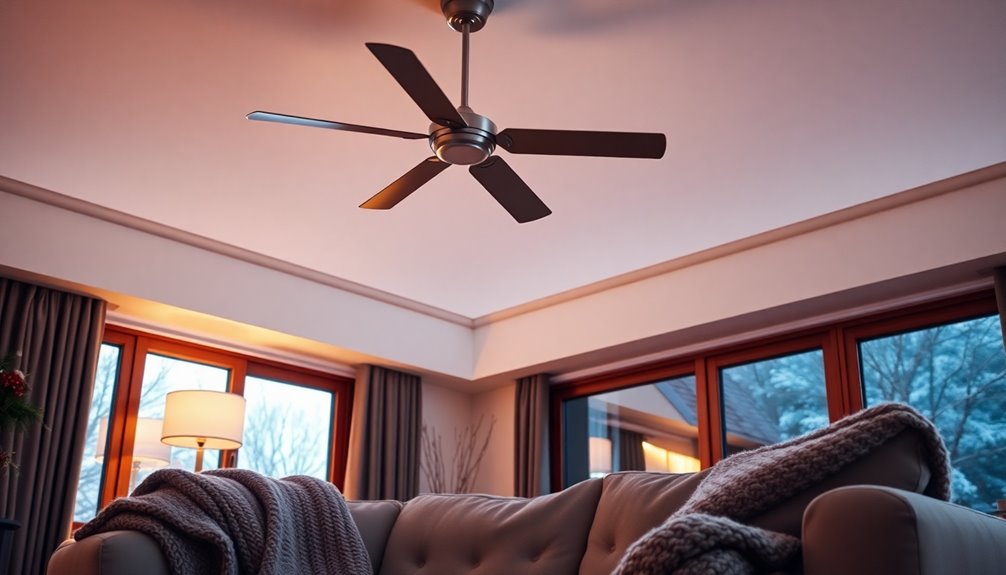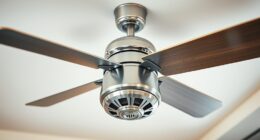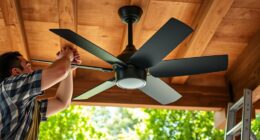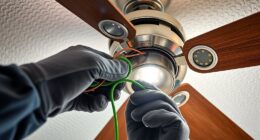In summer, your ceiling fan should turn counterclockwise to create a cool downdraft. This direction boosts airflow and enhances comfort, allowing you to raise your thermostat settings by about 4 degrees without feeling uncomfortable. You'll enjoy a revitalizing breeze that helps cool your space more efficiently. To change the direction, simply turn off the fan and use the pull chain or remote control. It's important to verify the fan blades are angled correctly for maximum airflow. By following these tips, you can not only beat the heat but also discover other ways to optimize your cooling methods.
Key Takeaways
- In summer, ceiling fans should rotate counterclockwise to create a cooling downdraft for enhanced airflow.
- A counterclockwise rotation allows you to raise thermostat settings by about 4 degrees without discomfort.
- Set the fan to high speed for maximum airflow efficiency and cooling benefits.
- Ensure the blades have a minimum angle of 12 degrees for optimal performance.
- Regularly check the fan direction and clean the blades to maintain effectiveness and energy efficiency.
Importance of Ceiling Fan Direction

When it comes to keeping your home comfortable in the summer, the direction of your ceiling fan plays a crucial role. Setting your ceiling fan to rotate counterclockwise can create a revitalizing downdraft that helps circulate cooler air throughout the room. This simple adjustment can make a significant difference in your comfort level while also impacting energy efficiency.
By using your ceiling fan in this direction, you can raise your thermostat settings by about 4 degrees without losing comfort. This not only enhances your cooling experience but also leads to substantial savings on air conditioning costs.
In fact, ceiling fans can reduce energy costs by up to 30%, making them a more efficient option compared to traditional air conditioning units, which consume around 3,500 watts.
Additionally, adjusting your fan's direction seasonally helps prevent overworking your cooling systems, ensuring a comfortable indoor environment while optimizing energy consumption.
Remember, using a ceiling fan typically requires only about 50 watts of energy, making it an excellent choice for both cooling and heating throughout the year.
Recommended Summer Settings

To maximize your ceiling fan's cooling efficiency in summer, set it to rotate counterclockwise.
This movement not only creates an invigorating downdraft but also lets you control the temperature more effectively.
Counterclockwise Movement Benefits
During the summer, setting your ceiling fan to rotate counterclockwise can greatly enhance your comfort and cooling experience. This direction creates a cooling downdraft that improves airflow in the room, allowing you to enjoy a more pleasant environment.
You'll notice the wind chill effect, making the air feel considerably cooler, which means you can raise your thermostat setting by about 4 degrees without sacrificing comfort.
By operating your ceiling fan counterclockwise, you're not just feeling cooler; you're also making a smart financial choice. This setting can reduce your air conditioning costs by up to 30%, leading to substantial energy savings.
To maximize airflow efficiency, verify the blades of the fan are angled at least 12 degrees.
When you stand under the fan, you should feel the cool air being pushed downward, confirming that the counterclockwise rotation is working effectively.
This simple adjustment to your ceiling fan can transform your summer experience, providing both comfort and savings while keeping your home cool. Embrace the benefits of counterclockwise movement and enjoy those breezy summer days! Additionally, proper fan usage can lead to lower energy bills, making this an even more attractive option for homeowners.
Optimal Fan Speed
Finding the right fan speed is crucial for maximizing your comfort in summer. To achieve the best results, set your ceiling fan to turn counterclockwise at high speed. This rotation creates a cooling downdraft, allowing you to enjoy a revitalizing cool breeze throughout your space.
Running your fan on high speed can also let you raise your thermostat settings by about 4 degrees without compromising comfort. You'll not only feel cooler, but you'll also save on energy costs. In fact, utilizing this ideal ceiling fan direction can reduce your air conditioning expenses by up to 30%.
To confirm your fan is operating correctly, stand beneath it and feel for the cool air rushing down. A minimum blade angle of 12 degrees is recommended to maximize airflow and cooling efficiency, so make certain your fan is properly adjusted.
Temperature Control Strategies
Effective temperature control in summer hinges on strategic adjustments to your thermostat and ceiling fan. To maximize comfort while keeping energy costs low, you should set your ceiling fan direction to rotate counterclockwise. This change creates a cooling downdraft that enhances airflow, making the air feel considerably cooler in the room.
You can easily raise your thermostat setting by about 4 degrees without sacrificing comfort when your fan is running correctly.
For ideal cooling, it's essential to operate your ceiling fan at a high speed during the summer months. This boosts the wind chill effect, which can make a notable difference in how the temperature feels. Additionally, using a ceiling fan in conjunction with heat pumps can further enhance energy efficiency and comfort levels in your home.
To verify your fan is spinning the right way, stand beneath it and feel for a strong breeze; this indicates proper counterclockwise rotation.
How to Change Direction

To change your ceiling fan's direction for summer, start by turning it off and letting it come to a complete stop.
Depending on your fan type, you'll either use a pull chain, remote control, or app to switch it to counterclockwise for ideal cooling.
Once you've made the adjustment, turn the fan back on to confirm it's rotating correctly.
Switching Fan Direction
Changing the direction of your ceiling fan for summer is a straightforward process that can enhance your comfort.
First, make certain to turn off the fan completely to guarantee safety before making any adjustments. If you have a pull chain fan, locate the reversing switch on the fan body and toggle it to change the direction. This will help the blades spin counterclockwise, which is perfect for cooling down your space.
For remote-controlled fans, turn off the fan and press and hold the fan button on the remote until you see a light blink, indicating the direction has changed.
If you own a smart fan, you can easily adjust the ceiling fan direction through compatible apps or voice commands using SIMPLEconnect® WiFi® technology.
Once you've made the change, turn the fan back on and confirm it's rotating counterclockwise. This is the ideal setting for summer, as it provides a rejuvenating breeze that helps lower the perceived temperature in your room.
Seasonal Adjustment Tips
Seasonal adjustments to your ceiling fan can greatly enhance your comfort during the warmer months. To keep cool, you'll want to change your ceiling fan direction to counterclockwise.
Here are some simple seasonal adjustment tips to help you make the switch safely and efficiently:
- Turn Off the Fan: Always guarantee your fan is turned off and has completely stopped before changing its direction. This prevents any damage or injury.
- Adjusting Pull Chain Fans: If you have a pull chain fan, locate the reversing switch on the fan body. Pull it to switch the rotation from clockwise to counterclockwise.
- Remote-Controlled Fans: For those with remote-controlled fans, turn the fan off and hold the fan button on the remote until you see a light blink. This indicates that the direction has been successfully changed.
Timing your change with Daylight Savings Time can serve as a helpful reminder to adjust your ceiling fan direction for the upcoming season.
Confirming Effective Rotation
Confirming effective rotation of your ceiling fan is vital for maximizing comfort during the summer months. To achieve this, start by verifying the fan is turned off and completely stopped. This step is important before you change the ceiling fan direction to counterclockwise, which allows for best cooling.
If you have a pull chain fan, locate the reversing switch on the fan body. Toggle this switch to change the direction to counterclockwise.
For remote-controlled fans, turn the fan off, then press and hold the fan button on the remote until you see a light blink, indicating that it's switched to counterclockwise rotation.
If you own a smart ceiling fan, adjusting the direction is even easier. Use a compatible app or voice commands to set it to counterclockwise.
Once you've made the change, turn the fan back on to confirm it's spinning counterclockwise. This rotation creates a cooling downdraft, enhancing air circulation and making your space feel more comfortable during the heat of summer.
Timing for Direction Changes

As the seasons shift, it's crucial to adjust your ceiling fan's direction to maximize comfort and energy efficiency.
To guarantee you're on top of the timing for direction changes, consider the following tips:
- Daylight Savings Time: Use the start and end of Daylight Savings Time in spring and fall as reminders to change the ceiling fan direction. This way, you'll seamlessly shift to the appropriate settings for each season.
- Summer Prep: When summer approaches, it's time to turn the fan to rotate counterclockwise. This fan direction in summer creates a cooling breeze, making your space more comfortable while potentially reducing air conditioning costs.
- Winter Adjustments: As winter arrives, change the ceiling fan to rotate clockwise. This promotes an updraft that helps distribute warm air, guaranteeing your room stays cozy.
Energy Savings With Proper Use

Adjusting your ceiling fan's direction is just the first step toward maximizing energy savings during the summer months. When you set your fan to rotate counterclockwise, it creates a cool downdraft that helps you feel cooler. This simple change can greatly enhance your comfort while reducing your reliance on air conditioning.
By using your ceiling fan correctly, you can raise your thermostat setting by about 4 degrees without sacrificing comfort, leading to substantial energy savings on your cooling costs. Ceiling fans consume only about 50 watts of energy, compared to the hefty 3,500 watts that air conditioning units use. This difference can translate into considerable savings on your electricity bills.
Additionally, if you pair your ceiling fan with an ENERGY STAR rated air conditioning unit, you can boost overall efficiency by up to 8%. Properly utilizing ceiling fans in the summer can yield energy savings of up to 30%.
Impact of Blade Angle

The blade angle of your ceiling fan plays an essential role in maximizing airflow and cooling efficiency during the summer. To achieve ideal performance, you should guarantee that the blade angle is set correctly. A minimum angle of 12 degrees is perfect, as it enhances air circulation and creates a revitalizing downdraft, keeping you comfortable in warmer months.
However, be cautious—angles greater than 16 degrees can lead to excessive turbulence, which may disrupt lightweight objects in the room.
Here are three key points to take into account regarding blade angle:
- Ideal Cooling: A well-adjusted blade angle boosts your ceiling fan's ability to cool the room effectively.
- Energy Savings: Properly angled ceiling fan blades can help reduce reliance on air conditioning, leading to better energy savings.
- Room Size Consideration: For larger spaces (over 500 square feet), using multiple fans with the correct blade angle can greatly enhance air circulation and overall comfort.
Specific Room Considerations

Understanding specific room considerations can greatly enhance your ceiling fan's performance during the summer. Each space has unique needs, and adjusting the ceiling fan direction accordingly can improve comfort and functionality.
| Room Type | Recommended Ceiling Fan Direction | Additional Notes |
|---|---|---|
| Dining Room | Counterclockwise (high speed) | Keeps food from cooling too quickly |
| Home Office | Counterclockwise (medium speed) | Guarantees air circulation without chaos |
| Vaulted Ceilings | Counterclockwise (year-round) | Prevents excessive wind chill effects |
| Outdoor Spaces | Counterclockwise | Aids in insect control and cooling |
| Smoking Areas | Counterclockwise | Draws smoke upwards for better ventilation |
For dining rooms, running your ceiling fan counterclockwise at high speed creates a pleasant breeze. In home offices, a medium speed keeps papers in place while circulating air. If you have vaulted ceilings, keep the fan on counterclockwise to avoid wind chill. Outdoor ceiling fans should also rotate counterclockwise to maximize comfort and reduce bugs. Finally, in rooms used by smokers, this direction helps ventilate smoke effectively. Adjust your fan for each space to enjoy a cooler summer!
Maintenance Tips for Fans

To keep your ceiling fan running efficiently in the summer, regular maintenance is vital. A well-maintained fan not only enhances airflow but also prolongs its lifespan. Follow these tips to guarantee your fan remains in excellent shape:
- Clean the Blades: Regularly dust and clean the fan blades to prevent dust buildup. This keeps airflow ideal and increases efficiency. Wipe them down with a damp cloth every month.
- Inspect Connections: Periodically check and tighten all screws and bolts. A secure fan is essential for safe operation. Loose components can lead to vibrations and potential damage.
- Level the Blades: Use a leveling tool to align the blades properly. Confirm there's a minimum clearance of 10 inches from the ceiling for ideal performance. Misaligned blades can hinder airflow and reduce effectiveness.
Additionally, inspect the fan motor for any signs of wear or malfunction. Address issues promptly to avoid complete failure and replace any damaged blades to maintain airflow efficiency.
Additional Energy Efficiency Strategies

Maximize your energy savings this summer by implementing additional strategies alongside your ceiling fan usage. Conducting a home energy audit can help you pinpoint areas where energy efficiency can improve, potentially slashing your utility bills.
Start with simple changes like sealing windows and doors to eliminate drafts. When combined with proper ceiling fan usage, this can lead to considerable savings. Regularly maintaining your home's air quality with air purifiers can also contribute to a more comfortable living environment. Utilizing HEPA filtration in air purifiers effectively captures allergens, enhancing your indoor air quality. Additionally, consider RMDs as a strategy to better allocate your retirement funds toward home energy improvements. To ensure optimal performance, it's important to maintain the efficiency of your heat pump systems.
Regular maintenance of your ceiling fan is essential, too. Clean the blades and check the motor functionality to enhance performance and energy efficiency. Don't forget to adjust the ceiling fan switch to create a downward airflow, promoting cool air circulation.
Consider pairing your ceiling fan with an ENERGY STAR-rated air conditioner. This combo can boost your overall efficiency by up to 8%, further reducing energy costs. Additionally, utilizing energy-efficient heat pumps can provide year-round climate control while further reducing your energy bills.
Furthermore, educate yourself on energy-efficient practices like using programmable thermostats and switching to energy-saving light bulbs. These small changes can notably lower your home's energy consumption, allowing you to enjoy a cooler environment without breaking the bank. Regular filter replacement in air purifiers ensures continuous allergen removal, which can also improve overall comfort.
Frequently Asked Questions
How Can You Tell if a Fan Is Going Clockwise or Counterclockwise?
To tell if your fan's going clockwise or counterclockwise, stand directly underneath it.
Watch the blades: if they move to the right, it's spinning clockwise; if they move to the left, it's counterclockwise.
You can also feel the airflow—if you sense a cool breeze, it's likely counterclockwise.
Many fans have a switch on the motor, so check that to confirm its current rotation direction.
Which Way Should Fans Spin in Winter?
In winter, you should set your ceiling fan to spin clockwise at a low speed.
This creates a gentle updraft that pushes warm air down from the ceiling, helping to evenly heat your room and keeping it cozy.
By using this method, you can cut your heating bills by up to 15%, making it an efficient choice.
Just remember, keeping the speed low prevents any uncomfortable cold drafts during those chilly months.
How to Tell Fan Direction?
You're standing there, drenched in sweat, and your ceiling fan feels like it's just spinning in circles, right?
To figure out the fan's direction, stand directly beneath it and feel for a cool breeze. If you're not feeling that invigorating gust, it's probably spinning the wrong way!
Check the blade motion too; they should move from the top left to the bottom right. Adjust the switch if necessary, and enjoy your cool oasis!
Which Way Should Ceiling Fans Go When Heat Is On?
When the heat's on, you want your ceiling fan to spin clockwise. This direction pushes warm air down from the ceiling, creating a cozy and even temperature throughout the room.
It helps circulate that rising warm air, making your space feel more comfortable without cranking up the thermostat. By running your fan this way, you can enjoy warmth while potentially saving on heating costs.
Just remember to adjust it seasonally for ideal comfort!
Conclusion
In summer, you want your ceiling fan to spin counterclockwise to create a cool breeze that refreshes your space like a gentle summer wind. By adjusting the fan's direction and using it wisely, you can not only beat the heat but also save on energy costs. Remember, a little maintenance goes a long way in keeping your fan running smoothly. So, embrace these tips and let your fan work its magic all season long!









